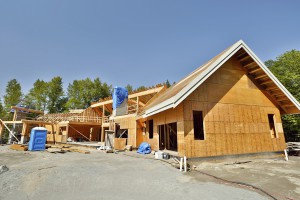I live and work home building. My husband is a home builder; I manage the construction loans for INB. I’ve been doing the job for 15 years now, yet it’s still a thrill to walk a new customer through the construction loan process. I know when people are willing to take this gigantic leap and build a home, they’re about to go on an amazing ride toward owning something that has their personal stamp.

Just like the mortgage loan process is a series of steps, the construction loan process can seem overwhelming. But when we break it down into sizeable chunks, it simply makes the road to the mortgage loan a more streamlined process because we’ll have already laid the groundwork through the construction loan.
How to Qualify for a Construction Loan
Just like you don’t want to go into the home buying process without knowing your budget, you don’t want to begin looking at floor plans and lots without knowing how much money you’ll be able to borrow. Begin by completing our on-line mortgage loan application. We will send you preliminary disclosures to sign and return, and then ask you to provide me with information. I’ll need your paystubs from the last month, your last two year’s tax returns and w2s, and your last two month’s bank statements. With this information, we can give you a general idea of how much money we’ll be able to loan you.
Meet the Builder
With a budget in hand, you can meet with a homebuilder to determine location and the type of home you’d like. Once you have a blueprint, the builder can discuss building costs. You’ll get a comprehensive list of everything that will go into your home. Once you and your builder agree on these items, you’ll enter into a written construction contract.
INB needs these items before approving the construction loan:
- A fully signed and completed contract including all addendums
- Contractor’s cost breakdown
- Plans and specifications
- Description of materials
The contractor’s cost breakdown should list all subcontractors and material suppliers along with the dollar amount of each contract. The plans should include, at a minimum, a floor plan and a front and rear view of the home. With these in hand, we’ll order an appraisal for the proposed home. The appraiser will determine your home’s value by comparing the plans to recently sold homes that are similar in size and features. With this information, I’ll set up the construction loan.
As part of the loan contingency, you’ll need to purchase Builder’s Risk Insurance for at least the amount of the loan prior to the closing date of the loan.
Let’s Start Building
Once your general contractor gets going, once a month you’ll receive a Contractor’s Verified Statement for services rendered and materials used in the home construction. Everything on the list will be backed up with a receipt.
It’s your responsibility to review the contractor’s statement and approve the payout(s) prior to being submitted to the bank for payment processing. We will inspect the construction before making our disbursements. We’ll make the disbursements by check payable to the individual suppliers or subcontractors provided on the contractor’s statement. It takes us two to five days to process these payments.
If there are goods or services that cost more than planned in the original estimate, the general contractor needs to provide verification. You’ll then be responsible for these overages before we can begin dispersing money from your construction loan.
Time for the Home Mortgage
Once your home is almost complete, I can arrange a meeting for you and a mortgage lender to discuss mortgage loan products. They’ll help you through the process of getting permanent financing on your new home. Once the home construction is complete, the appraiser will make a final inspection. Once he or she states the home is 100 percent complete, and we have final lien waiver clearance from the title company, we’ll be able to move you to a mortgage loan that best fits your circumstances.